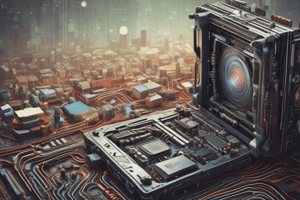Podcast
Questions and Answers
The CPU performs calculations and executes instructions.
The CPU performs calculations and executes instructions.
True (A)
The Motherboard is responsible for providing power to all components.
The Motherboard is responsible for providing power to all components.
False (B)
Application Software is used to manage computer hardware.
Application Software is used to manage computer hardware.
False (B)
A keyboard is an example of an Output Device.
A keyboard is an example of an Output Device.
RAM is a type of permanent storage.
RAM is a type of permanent storage.
The binary number system uses only three digits.
The binary number system uses only three digits.
A byte is a group of 4 bits.
A byte is a group of 4 bits.
The primary function of the Power Supply is to provide temporary storage for data and programs.
The primary function of the Power Supply is to provide temporary storage for data and programs.
A scanner is an example of an Output Device.
A scanner is an example of an Output Device.
Binary code is used to represent numbers, characters, and instructions in computers.
Binary code is used to represent numbers, characters, and instructions in computers.
Flashcards are hidden until you start studying
Study Notes
Hardware Components
- CPU (Central Processing Unit): executes instructions and performs calculations
- Motherboard: main circuit board connecting all hardware components
- RAM (Random Access Memory): temporary storage for data and programs
- Storage Devices: hold data and programs (e.g., hard drives, solid-state drives)
- Power Supply: provides power to all components
- Input/Output Devices: interact with users (e.g., keyboard, mouse, monitor)
Software Classification
- System Software: manages computer hardware and provides platform for running applications
- Operating System (OS)
- Device drivers
- Utilities
- Application Software: performs specific tasks or functions
- Productivity software (e.g., Microsoft Office)
- Graphics and design software (e.g., Adobe Photoshop)
- Games
Input/Output Devices
- Input Devices: allow users to enter data or commands
- Keyboard
- Mouse
- Scanner
- Microphone
- Output Devices: display or produce output
- Monitor
- Printer
- Speakers
- Plotter
Primary Memory
- RAM (Random Access Memory): temporary storage for data and programs
- Volatile (loses data when power is turned off)
- Fast access times
- ROM (Read-Only Memory): permanent storage for data and programs
- Non-volatile (retains data when power is turned off)
- Slow access times
Binary Number System
- Base 2: uses only two digits (0 and 1)
- Bit: single binary digit (0 or 1)
- Byte: group of 8 bits
- Binary Representation: represents numbers, characters, and instructions using binary code
- Advantages:
- Simple to implement and understand
- Fast and efficient processing
- Universal language for computers
Hardware Components
- The Central Processing Unit (CPU) executes instructions and performs calculations in a computer system.
- The Motherboard is the main circuit board that connects all hardware components together.
- Random Access Memory (RAM) provides temporary storage for data and programs, and data is lost when the power is turned off.
- Storage Devices, such as hard drives and solid-state drives, hold data and programs for long-term storage.
- The Power Supply provides power to all components of a computer system.
- Input/Output Devices, such as keyboards, mice, and monitors, interact with users and provide input/output functionality.
Software Classification
System Software
- System Software manages computer hardware and provides a platform for running applications.
- The Operating System (OS) manages hardware resources and provides a platform for running applications.
- Device drivers control hardware devices and allow the OS to interact with them.
- Utilities perform maintenance and management tasks on a computer system.
Application Software
- Application Software performs specific tasks or functions.
- Productivity software, such as Microsoft Office, provides tools for creating documents, spreadsheets, and presentations.
- Graphics and design software, such as Adobe Photoshop, provides tools for creating and editing images.
- Games provide entertainment and leisure activities.
Input/Output Devices
Input Devices
- Keyboards allow users to enter text and commands into a computer system.
- Mice and other pointing devices allow users to interact with graphical user interfaces.
- Scanners and cameras capture images and video for use in computer systems.
- Microphones capture audio input for use in computer systems.
Output Devices
- Monitors display graphical output from a computer system.
- Printers produce physical output from a computer system.
- Speakers and headphones produce audio output from a computer system.
- Plotters produce printed output for use in computer-aided design (CAD) systems.
Primary Memory
- RAM (Random Access Memory) provides temporary storage for data and programs, and data is lost when the power is turned off.
- ROM (Read-Only Memory) provides permanent storage for data and programs, and data is retained when the power is turned off.
- RAM has faster access times than ROM, but ROM is non-volatile.
Binary Number System
- The Binary Number System uses a base 2 system, with only two digits (0 and 1).
- A bit is a single binary digit (0 or 1).
- A byte is a group of 8 bits.
- The Binary Number System represents numbers, characters, and instructions using binary code.
- The advantages of the Binary Number System include simplicity, speed, and universality across computer systems.
Studying That Suits You
Use AI to generate personalized quizzes and flashcards to suit your learning preferences.




